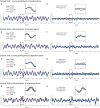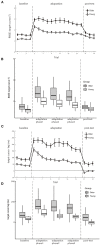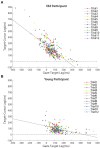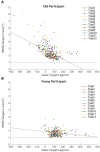Age-related decline of online visuomotor adaptation: a combined effect of deteriorations of motor anticipation and execution
- PMID: 37409009
- PMCID: PMC10318141
- DOI: 10.3389/fnagi.2023.1147079
Age-related decline of online visuomotor adaptation: a combined effect of deteriorations of motor anticipation and execution
Abstract
The literature has established that the capability of visuomotor adaptation decreases with aging. However, the underlying mechanisms of this decline are yet to be fully understood. The current study addressed this issue by examining how aging affected visuomotor adaptation in a continuous manual tracking task with delayed visual feedback. To distinguish separate contributions of the declined capability of motor anticipation and deterioration of motor execution to this age-related decline, we recorded and analyzed participants' manual tracking performances and their eye movements during tracking. Twenty-nine older people and twenty-three young adults (control group) participated in this experiment. The results showed that the age-related decline of visuomotor adaptation was strongly linked to degraded performance in predictive pursuit eye movement, indicating that declined capability motor anticipation with aging had critical influences on the age-related decline of visuomotor adaptation. Additionally, deterioration of motor execution, measured by random error after controlling for the lag between target and cursor, was found to have an independent contribution to the decline of visuomotor adaptation. Taking these findings together, we see a picture that the age-related decline of visuomotor adaptation is a joint effect of the declined capability of motor anticipation and the deterioration of motor execution with aging.
Keywords: aging; eye movement; manual tracking; online control; visuomotor adaptation.
Copyright © 2023 Li, Liu, Xie, Ji and Chen.
Conflict of interest statement
The authors declare that the research was conducted in the absence of any commercial or financial relationships that could be construed as a potential conflict of interest.
Figures









Similar articles
-
Aging Effect on Visuomotor Adaptation: Mediated by Cognitive Decline.Front Aging Neurosci. 2021 Oct 28;13:742928. doi: 10.3389/fnagi.2021.742928. eCollection 2021. Front Aging Neurosci. 2021. PMID: 34776929 Free PMC article.
-
Eye movements do not play an important role in the adaptation of hand tracking to a visuomotor rotation.J Neurophysiol. 2019 May 1;121(5):1967-1976. doi: 10.1152/jn.00814.2018. Epub 2019 Apr 3. J Neurophysiol. 2019. PMID: 30943096
-
Real-time error detection but not error correction drives automatic visuomotor adaptation.Exp Brain Res. 2010 Mar;201(2):191-207. doi: 10.1007/s00221-009-2025-9. Epub 2009 Oct 15. Exp Brain Res. 2010. PMID: 19830412 Clinical Trial.
-
Visuomotor Tracking Task for Enhancing Activity in Motor Areas of Stroke Patients.Brain Sci. 2022 Aug 10;12(8):1063. doi: 10.3390/brainsci12081063. Brain Sci. 2022. PMID: 36009126 Free PMC article.
-
An Integrative Framework of Stress, Attention, and Visuomotor Performance.Front Psychol. 2016 Nov 1;7:1671. doi: 10.3389/fpsyg.2016.01671. eCollection 2016. Front Psychol. 2016. PMID: 27847484 Free PMC article. Review.
Cited by
-
VR Cognitive-based Intervention for Enhancing Cognitive Functions and Well-being in Older Adults with Mild Cognitive Impairment: Behavioral and EEG Evidence.Psychosoc Interv. 2025 Jan 2;34(1):37-51. doi: 10.5093/pi2025a4. eCollection 2025 Jan. Psychosoc Interv. 2025. PMID: 39781014 Free PMC article.
References
-
- Alvarez-Aguirre A., Van d. W. N., Oguchi T., Nijmeijer H. (2014). Predictor-based remote tracking control of a mobile robot. IEEE Transact. Cont. Sys. Technol. 22, 2087–2102. 10.1109/TCST.2014.2304741 - DOI
LinkOut - more resources
Full Text Sources

